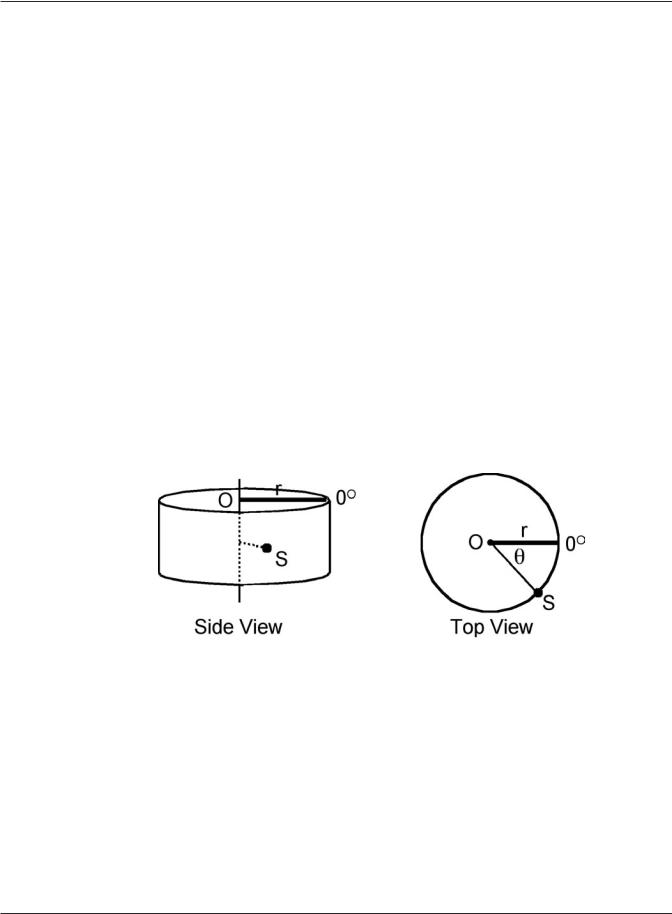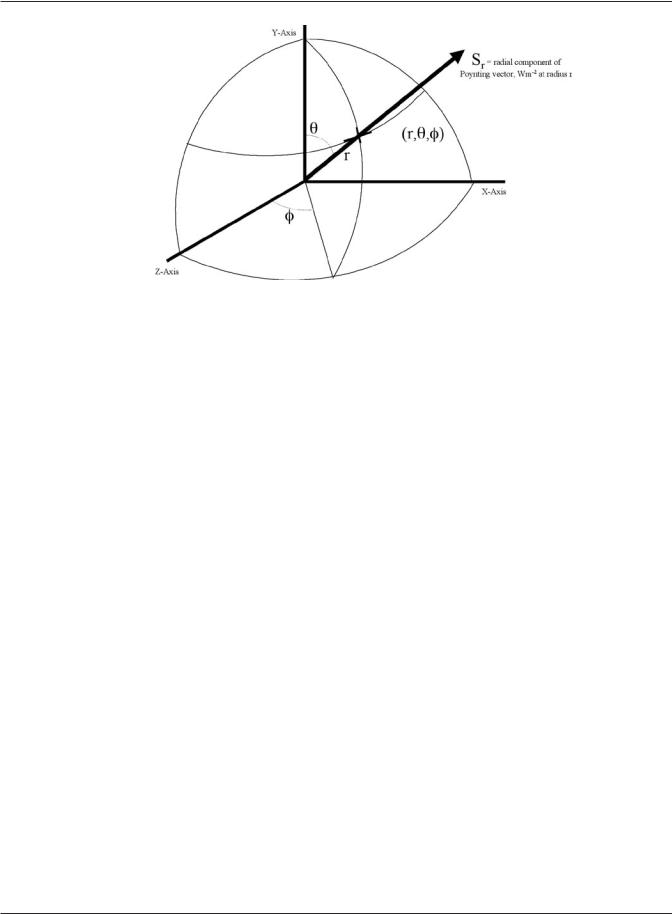
- •Math and Physics for the 802.11 Wireless LAN Engineer
- •About the Author
- •Section 1: Introduction
- •Are You the Professor, or the Chauffeur?
- •Purpose and Perspective
- •Apprehensive Attitudes Resulting from Lack of Knowledge
- •What You’ll Learn in this Paper
- •A Note to the Reader Familiar with the Subject
- •Section 2: Electricity and Electromagnetic Fields
- •Electrical Force
- •Resistance and Reactance
- •Power Measurement
- •Watts, Milliwatts, Decibels, and dBm Units of Measurement
- •Magnetic Fields
- •Figure 2.1 The Magnetic Field Surrounding a Current Carrying Conductor
- •Zeno’s Paradoxes
- •Bardwell’s ERP Paradox
- •Section 3: The Electromagnetic Spectrum
- •Figure 3.1 The Electromagnetic Spectrum
- •The Shape of the Electromagnetic Field
- •Figure 3.2 The Spherical Radiation Pattern of a Theoretical Isotropic Radiator
- •Figure 3.3 The Doughnut-Shape of the Electromagnetic Radiation Pattern
- •Particles and Waves
- •Figure 3.4 A Beam of Light Reflecting From the Surface of a Mirror
- •Figure 3.5 A Beam of Light Manifesting Fresnel Diffraction
- •Figure 3.6 A 15-mile Span Using 6 Antennae and 2 Repeaters
- •Figure 3.7 Monthly Sunspot Activity Since 1950
- •The Electromotive Force
- •Scalar and Vector Measurement Metrics
- •Figure 3.8 Hiking in the Las Trampas Wildlife Refuge
- •Measuring the Characteristics of the Electromagnetic Field
- •Differentiation of Functions with One Independent Variable
- •Figure 3.9 Position Versus Time and the Rate of Change
- •Figure 3.10 The Notation for Differentiation
- •Differentiation of Functions With More Than One Independent Variable
- •Magnetic Flux Density (B) and the Vector Potential (A)
- •Figure 3.11 Partial Differentiation to Compute the Components of B
- •Figure 3.12 Basic Maxwell Wave Equations in Vector Form
- •Section 4: Electromagnetic Field Propagation
- •Time Symmetry and the Reciprocity Theorem
- •Practical Considerations Related to Antenna Reciprocity
- •Figure 4.1 Correct and Incorrect 802.11 Access Point Antenna Orientation
- •Transmitters and Receivers with Different Power Levels
- •Propagation of Electromagnetic Waves in Space
- •Figure 4.2 The Radiating Elements of a Dipole Antenna
- •Figure 4.3 Wavefront Formation with a Dipole Radiator
- •Figure 4.4 The Electromagnetic Field Surrounding a Dipole Antenna
- •Coupling and Re-radiation
- •Representing the Direction of Field Propagation
- •The Transverse Wavefront
- •Figure 4.5 Surface Area Defined On the Spherical Wavefront
- •Figure 4.6 An 802.11 NIC Encounters a Flat, Planar Wavefront
- •The Electromagnetic Field Pattern
- •Polar Coordinate Graphs of Antennae Field Strength
- •Figure 4.7 The Elevation Cut View of Antennae in a Warehouse
- •Figure 4.8 The Azimuth Cut View of a Directional Antenna
- •Figure 4.9 Polar Coordinate Graphs for an Omni-Directional Antenna
- •Figure 4.10 Vertical and Horizontal Cuts of an Apple
- •Figure 4.11 Close-up View of the Elevation Cut Polar Coordinate Graph
- •Figure 4.12 The Omni-Directional Elevation Cut Seen in the Warehouse
- •Figure 4.13 Polar Coordinate Graphs for a Directional Antenna
- •Figure 4.14 The Elevation Cut Rotated to the Left
- •Figure 4.15 The Directional Antenna’s Elevation Cut Seen in the Warehouse
- •The “E” Graph and the “H” Graph
- •Half-Power Beam Width
- •Figure 4.16 Antenna Field Pattern and Half Power Beam Width Measurement
- •Half-Power Beamwidth on a Polar Coordinate Graph
- •Figure 4.17 Identifying Half-Power Beamwidth (HPBW) Points
- •Figure 4.18 Horizontal and Vertical Beamwidth for a Directional Antenna
- •Figure 4.19 The Field Pattern for a Full Wavelength Dipole Antenna
- •Figure 4.20 The Field Pattern for a Half-Wavelength Dipole Antenna
- •Use of the Unit Vector
- •802.11 Site Considerations Related to Beamwidth
- •A Challenging Beamwidth Question
- •Figure 4.21 The Client and the Access Point Are Within Each Other’s HPBW Zone
- •Signal Strength and Reduced Data Rate
- •Figure 4.22 User #1 Is Outside the Beamwidth Angle of the Access Point
- •Physical Measurements Associated With the Polar Coordinate Graph
- •Figure 4.23 The Polar Elevation Cut as it Relates to a Real-World Situation
- •RF Modeling and Simulation
- •Figure 4.24 Results of an RF Simulation
- •Section 5: Electromagnetic Field Energy
- •The Particle Nature of the Electromagnetic Field
- •Field Power and the Inverse Square Law
- •Figure 5.1 Determining the Surface Area of a Sphere
- •Electric Field Strength Produced By An Individual Charge
- •Figure 5.2 The Strength of the Electric Field for an Individual Charge
- •Time Delay and the Retarded Wave
- •Figure 5.2 (repeated) The Strength of the Electric Field for an Individual Charge
- •The Derivative of the Energy With Respect To Time
- •Effective Radiated Power
- •The Near Field and the Far Field
- •Figure 5.3 The Far Field Transformation of the Field Strength
- •Signal Acquisition from the Spherical Wavefront
- •Figure 5.4 The Spherical Presentation of the Wavefront
- •Figure 5.5 An Impossible Antenna of Unreasonable Length
- •The Boundary Between the Near Field and the Far Field
- •Figure 5.6 Out of Phase Signals Meeting a Vertical Antenna
- •Figure 5.7 A Close View of the Out of Phase Waves
- •Characteristics of the Far Field
- •Considerations Concerning Near Field Interaction
- •The Reactive Near Field and the Radiating Near Field
- •Antenna Gain and Directivity
- •Figure 5.8 A Spherical Versus a Toroidal Radiation Pattern
- •Phased Array Design Concepts
- •Figure 5.9 Top-View of Canceling Fields Parallel to the Two Radiators
- •Figure 5.10 Top-View of Augmenting Fields Perpendicular to the Two Radiators
- •Figure 5.11 A Multiple Element Phased Array Field Pattern
- •Parasitic Element Design Concepts
- •Figure 5.12 The Yagi-Uda Antenna
- •Antenna Beamwidth and the Law of Reciprocity
- •Figure 5.13 The Depiction of an Antenna’s Beamwidth
- •Section 6: The Huygens-Fresnel Principle
- •Figure 6.1 A Spherical Wavefront from an Isotropic Radiator
- •Figure 6.2 Each New Point Source Generates a Wavelet
- •Applying the Huygens-Fresnel Principle in the 802.11 Environment
- •Figure 6.3 An Obstruction Causes the Wavefront to Bend
- •Diffraction of the Expanding Wavefront
- •How Interference Relates To Diffraction
- •Figure 6.4 Wavelets Combining Out of Phase at the Receiver
- •Figure 6.5 The Critical Angle at Which the Wave is 180O Out of Phase
- •Figure 6.6 The Effect of an Obstruction on the Received Wavelets
- •Figure 6.7 The Receiver’s Location Determines the Obstructions Affect
- •Fresnel Zones
- •Figure 6.8 The Oval Volume of a Fresnel Zone
- •Figure 6.9 Multiple Fresnel Zones Built Up Around the Central Axis
- •Fresnel Zones are not Related to Antenna Gain or Directivity
- •Calculating the Radius of the Fresnel Zones
- •Obstructions in the First Fresnel Zone
- •Figure 6.10 Interior Obstructions in the First Fresnel Zone
- •Practical Examples of the Fresnel Zone Calculation
- •The Fresnel Construction
- •Figure 6.11 The Pythagorean Construction of the First Fresnel Zone
- •Figure 6.12 Two Triangles Are Constructed Between Transmitter and Receiver
- •Dealing with an Unfriendly Equation
- •One More Equation
- •The Erroneous Constant of Proportionality
- •Figure 6.13 The Typical Presentations of the Fresnel Zone Equations
- •Concluding Thoughts
- •Appendix A
- •The Solution To Zeno’s and Bardwell’s Paradoxes
- •Appendix B
- •Trigonometric Relationships: Tangent, Sine, and Cosine
- •Figure B.1: Trigonometric Relationships In Right Triangles
- •Figure B.2: The Basic Trigonometric Relationships in a Right Triangle
- •Appendix C
- •Representational Systems for Vector Description
- •Figure C.1 Vectors Represented Using Cylindrical Coordinates
- •Figure C.2 The Spherical Coordinate System
- •Appendix D
- •Electromagnetic Forces at the Quantum Level
- •Appendix E
- •Enhanced Bibliography

Appendix C
Representational Systems for Vector Description
Mathematicians have developed more than a dozen ways of representing the special relationships between physical things. Three of these that are often encountered are through the use of coordinate axes, cylindrical coordinates, and spherical coordinates.
A street map is a two dimensional representation of a town and, like the simple coordinate plane (with an X and a Y axis) that you may have used in school, any location can be represented with a horizontal (X) and vertical (Y) value. A Z-axis can be added to the picture so that any point in space can be identified as P(x,y,z), where the three coordinates are plotted on three axes of the coordinate plane. When you see strange formulae in some antenna book or in some web article discussing electromagnetism (or anything else, for that matter) and you see that 3-dimensional coordinates are presented as an x, y, and z value, you know youʼre using the classic coordinate axes method of representation.
Electronics (and many other disciplines) often involves evaluation of a plane thatʼs wrapped into a circle (a cylinder), like a piece of wire. A second representational system has been developed for
solving equations involving a cylinder. Thereʼs a number and an angle that represents the distance up or down the cylinder at which the point being referenced is located and then the angle based on some 0O on the circle that forms the end of the cylinder. This is called a cylindrical representation (…no surprise there!). When you see an equation where position is represented by two numbers and an angle youʼre working with a cylindrical format, as shown below.
Figure C.1 Vectors Represented Using Cylindrical Coordinates
On the left (Figure C.1 above) is the side view of the representation. A line with length r extends from the vertical line in the middle of the cylinder (at point O) to the circumference of the cylinder. This line has been defined as the 0O line. Below the radial line at O is another line, meeting the circumference of the cylinder at point S. The angle (clearly seen in the top view) between the two lines is shown as θ. A vector represented in cylindrical form would be written S(y,r,θ), giving the point on the vertical y-axis for the origin of the vector, the radius of the cylinder, and the angle formed relative to 0O.
Ultimately, equations often involve points that are naturally in spherical relationships to one-another (like the energy points in a spherically expanding wavefront). The spherical coordinate system (widely used in dealing with electromagnetic radiation equations) is represented below in Figure C.2.
Math and Physics for the 802.11 Wireless LAN Engineer |
92 |
Copyright 2003 - Joseph Bardwell

Figure C.2 The Spherical Coordinate System
As you examine the spherical coordinate system figure (above) you see that a particular direction (Sr, the radial component of a Poynting vector in units of Watts per square meter) is shown emanating from the point where the X-, Y-, and Z-axis meet in the center. Instead of representing a point on Sr with an x, y, and z coordinate the angle from the x-axis towards the y-axis is given as θ (theta) and the angle from the x-axis towards the z-axis is given as φ (rho). A point at distance r from the center is represented as (r, θ,φ).
Math and Physics for the 802.11 Wireless LAN Engineer |
93 |
Copyright 2003 - Joseph Bardwell
